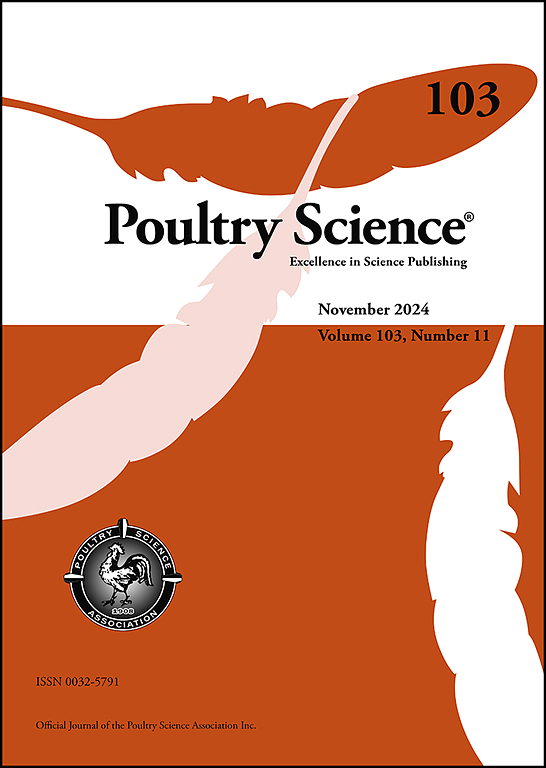The feather growth process of Cherry valley duck embryo Ⅰ: Nonlinear model fitting analysis and feather follicle development detection
IF 4.2
1区 农林科学
Q1 AGRICULTURE, DAIRY & ANIMAL SCIENCE
引用次数: 0
Abstract
Feathers are defining characteristics of birds, and the specific feather structure of waterfowl contributes to their economic value. In recent years, feather quality has become one of the conventional evaluation indexes of meat ducks. However, a systematic exploration of feather growth patterns in meat ducks is still lacking, and the optimal time points for regulation remain unclear. In this study, Cherry Valley ducks at 11 different embryonic stages were selected to investigate feather growth patterns and feather follicle development procedure. Logistic, Bertalanffy, and Gompertz models were applied for nonlinear regression analysis. Results showed .All three curve models effectively captured the dynamics of feather growth in Cherry Valley ducks during the embryonic period, with goodness-of-fit values exceeding 0.94. Among these models, the Gompertz curve provided the best fit for the feather mass, and the Bertalanffy curve for the feather length in Cherry Valley ducks during embryonic development. Furthermore, embryonic age (E) 18 was identified as a pivotal turning point in feather development.
The study also observed that both the width and depth of feather follicles increased with advancing embryonic age. Additionally, the diameters and densities of primary and secondary feather follicles exhibited a positive correlation with embryonic age. The application of mathematical models to characterize the developmental patterns of feathers serves as a useful tool for managing feather growth through nutrition and husbandry practices. These findings offer valuable insights for studying the regulation of feather development and addressing feather-related challenges in poultry production.
樱桃谷鸭胚胎羽毛生长过程Ⅰ:非线性模型拟合分析及羽毛毛囊发育检测
羽毛是鸟类的决定性特征,水禽的特殊羽毛结构有助于它们的经济价值。近年来,羽毛质量已成为肉鸭的常规评价指标之一。然而,对肉鸭羽毛生长模式的系统探索仍然缺乏,调控的最佳时间点仍然不清楚。本试验选用11个不同胚胎阶段的樱桃谷鸭,研究其羽毛生长模式和毛囊发育过程。采用Logistic、Bertalanffy和Gompertz模型进行非线性回归分析。结果表明:3种曲线模型均能较好地反映樱桃谷鸭胚胎期羽毛生长动态,拟合优度均超过0.94。其中Gompertz曲线和Bertalanffy曲线最适合樱桃谷鸭胚胎发育时期的羽毛质量,Bertalanffy曲线最适合樱桃谷鸭的羽毛长度。此外,胚胎年龄(E) 18被认为是羽毛发育的关键转折点。研究还发现,羽毛毛囊的宽度和深度随胚胎年龄的增加而增加。初生和次生毛囊的直径和密度与胚龄呈正相关。应用数学模型来描述羽毛的发育模式是通过营养和饲养实践来管理羽毛生长的有用工具。这些发现为研究羽毛发育的调控和解决家禽生产中与羽毛相关的挑战提供了有价值的见解。
本文章由计算机程序翻译,如有差异,请以英文原文为准。
求助全文
约1分钟内获得全文
求助全文
来源期刊

Poultry Science
农林科学-奶制品与动物科学
CiteScore
7.60
自引率
15.90%
发文量
0
审稿时长
94 days
期刊介绍:
First self-published in 1921, Poultry Science is an internationally renowned monthly journal, known as the authoritative source for a broad range of poultry information and high-caliber research. The journal plays a pivotal role in the dissemination of preeminent poultry-related knowledge across all disciplines. As of January 2020, Poultry Science will become an Open Access journal with no subscription charges, meaning authors who publish here can make their research immediately, permanently, and freely accessible worldwide while retaining copyright to their work. Papers submitted for publication after October 1, 2019 will be published as Open Access papers.
An international journal, Poultry Science publishes original papers, research notes, symposium papers, and reviews of basic science as applied to poultry. This authoritative source of poultry information is consistently ranked by ISI Impact Factor as one of the top 10 agriculture, dairy and animal science journals to deliver high-caliber research. Currently it is the highest-ranked (by Impact Factor and Eigenfactor) journal dedicated to publishing poultry research. Subject areas include breeding, genetics, education, production, management, environment, health, behavior, welfare, immunology, molecular biology, metabolism, nutrition, physiology, reproduction, processing, and products.
 求助内容:
求助内容: 应助结果提醒方式:
应助结果提醒方式:


